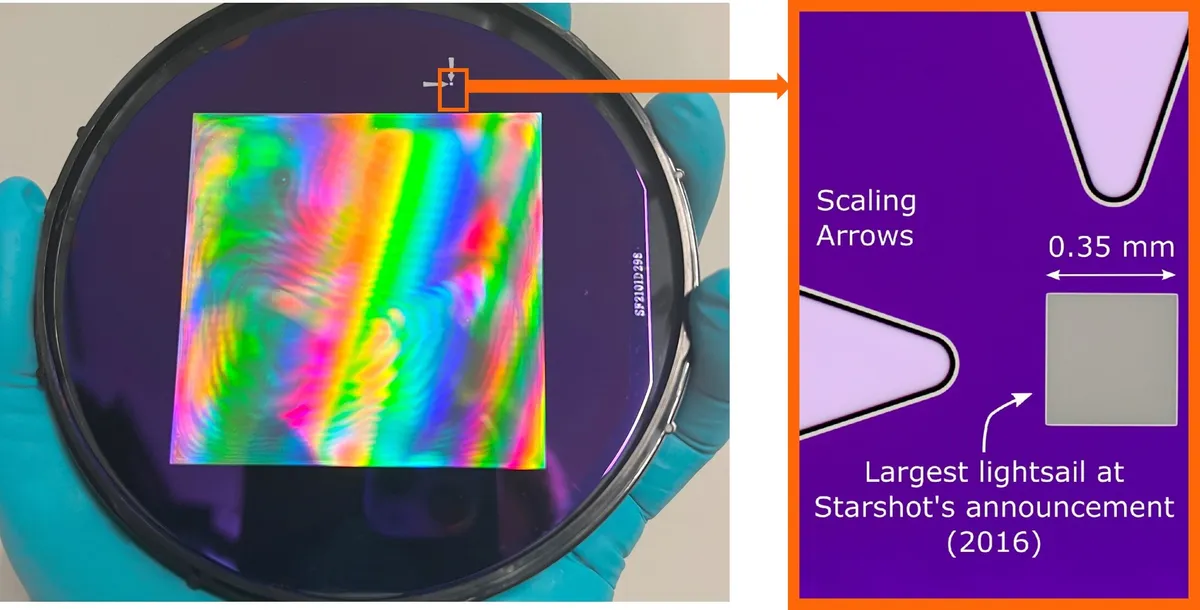
Researchers at TU Delft and Brown University have made significant strides in the realm of scalable nanotechnology with the development of innovative lightsails, which could play a crucial role in future space exploration and experimental physics. Their groundbreaking research, recently published in Nature Communications, introduces advanced materials and production methods that enable the creation of the thinnest large-scale reflectors ever engineered.
Lightsails are ultra-thin, reflective structures designed to harness laser-driven radiation pressure, propelling spacecraft at remarkably high speeds. Unlike traditional nanotechnology, which focuses on miniaturizing devices in all dimensions, lightsails adopt a unique approach. They possess a thickness on the nanoscale—approximately 1/1000th the thickness of a human hair—while being capable of extending into large sheets.
Traditionally, fabricating a lightsail suitable for the Breakthrough Starshot Initiative would take around 15 years due to its complex structure, which includes billions of nanoscale holes. However, the research team, led by first author and Ph.D. student Lucas Norder, has drastically reduced this timeline to just one day using advanced techniques. This innovative process not only speeds up production but also represents a major leap forward in the fabrication of lightsails.
This research signifies a paradigm shift in how we conceive nanotechnology, explains Dr. Richard Norte, an associate professor at TU Delft. "We are developing high-aspect-ratio devices that are thinner than previously engineered materials but large enough to span dimensions similar to massive structures," he adds. The current prototype measures 60mm x 60mm and boasts a thickness of only 200 nanometers, showcasing billions of nanosized holes—a remarkable advancement in large-scale lightsail production.
While other advancements from institutions like Caltech have demonstrated control over sail structures at micrometer scales, the techniques developed by Norte and his colleagues scale up to centimeter-sized structures while maintaining nanoscale precision. If successfully scaled, these lightsails could stretch the length of seven football fields, with a minimal thickness of just a millimeter.
What makes this material extraordinary is the simultaneous integration of large-scale and nanoscale properties, rendering it both lightweight and highly reflective. To achieve this feat, the team utilized advanced neural topology optimization techniques alongside cutting-edge fabrication methods. "We have devised a new gas-based etching process that delicately removes material from beneath the sails, leaving only the sails intact," explains Norte. "While the sails may be fragile during manufacturing, once suspended, they exhibit considerable robustness."
Dr. Miguel Bessa from Brown University notes that their work merges the latest advances in optimization to explore unconventional designs. "By integrating neural networks with topology optimization, we have crafted designs that push the limits of nanophotonics and large-scale manufacturing," he states.
The proposed lightsails harness laser-driven radiation pressure to achieve astonishing velocities, paving the way for rapid interplanetary travel. For example, probes propelled by these lightsails could potentially reach Mars in the same timeframe it takes for international mail to arrive. Although such vast distances remain aspirational, recent studies indicate that similar lightsails can already be propelled over distances as small as picometers.
Norte and his team are currently preparing experiments to propel the new membrane sails over distances measured in centimeters against Earth's gravitational pull. While this may seem modest, it represents a staggering 10 billion times farther than any previous laser-pushed object.
Beyond the potential for space exploration, these materials open exciting avenues in experimental physics. The ability to accelerate masses to high velocities presents unprecedented opportunities for investigating light-matter interactions and relativistic physics at macroscopic scales. Dr. Norte emphasizes that this research places Delft at the forefront of nanoscale material science, as they explore new possibilities with today’s capabilities in nanofabrication, lasers, and design.
Currently, our fastest rockets would take around 10,000 years to reach even the nearest star outside our solar system. The Breakthrough Starshot Initiative, which brings together thousands of researchers, aims to drastically reduce that journey to just 20 years. By developing ultra-light, laser-propelled spacecraft the size of microchips, this project envisions humanity's first interstellar exploration beyond our solar system. Launched by Yuri Milner and Stephen Hawking in 2016, Starshot represents a bold step toward realizing interstellar travel.
In conclusion, the advancements made by the research teams at TU Delft and Brown University not only pave the way for innovative lightsails but also redefine the possibilities of nanotechnology and space exploration. As they continue to explore and develop these technologies, the future of interstellar travel may be closer than we ever imagined.